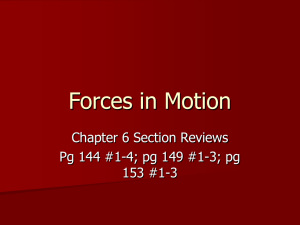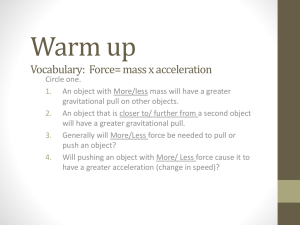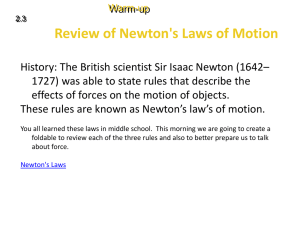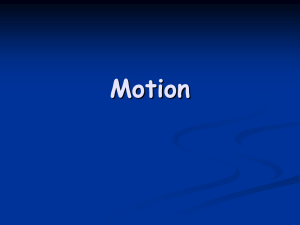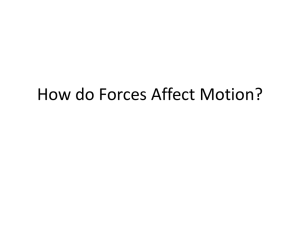Newton`s Laws of Motion
advertisement
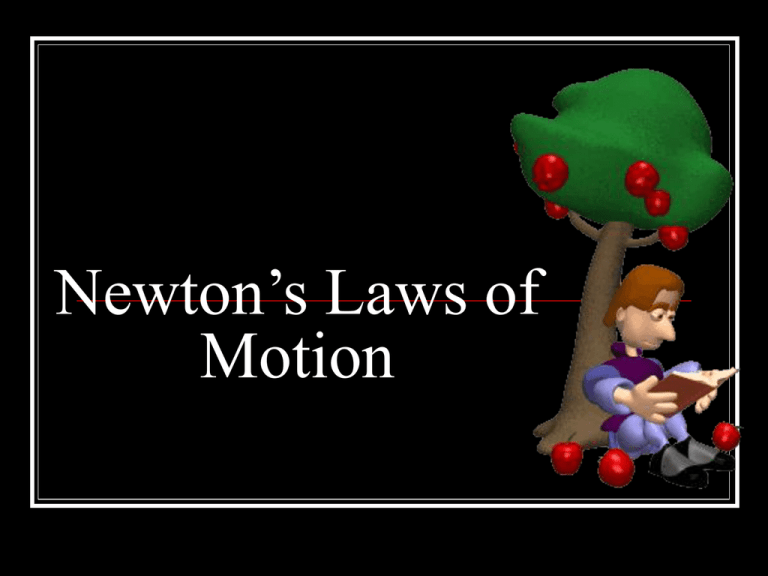
Newton’s Laws of Motion Newton’s First Law of Motion An object at rest will remain at rest and an object in motion will remain in motion at constant speed in the same direction unless an unbalanced force acts on it In other words: If something is just sitting there, it is not going to move on its own without a new force being introduced Likewise, if an object is moving, it will not stop moving without a new force being introduced Balanced or unbalanced? According to Newton’s first law, will an object’s motion change if an unbalanced force is not introduced? No! So, what is the net force on the object’s described by the first law? Zero Newtons! Resting? Are they asleep? Why are a chair on the floor and a golf ball sitting on a tee said to be “at rest”? They are not moving When will they no longer be at rest? When an unbalanced force is applied to them (golf club hits the ball or hand pushes the chair) and they begin to move It keeps going and going and going According to Newton’s First law, an object will continue to move forever with the same velocity unless an unbalanced force acts on it – what does this mean? Any object will continue to move in the same direction and at the same speed forever if left untouched by other forces What happens to a ball when it is left to roll on a field? It will eventually stop because friction slows it down What do you think would happen to a ball if left to “roll” in outer space? It will continue to “roll” because there is no friction in space to sow it down Bump in the night (or in the car) What happens to you when the bumper car you are riding in hits another bumper car? You keep moving forward even though the bumper car stops Hitting the other bumper car does not affect your motion, only the motion of your car That is why there are seat belts in bumper cars!! What about Friction? According to Newton’s first law, when you push your desk, it should continue to move forever, but it doesn’t – it stops quickly. Why? Friction between the desk and floor works against the motion of the desk Friction causes motion to slow down and eventually stop Inertia Newton’s First Law is also known as the Law of Inertia Inertia is the tendency of all objects to resist any change in their motion All objects either want to remain at rest, or keep moving This is why you are pushed to the door of the car when it turns Your body wants to continue to move forward, but the car begins to turn Increasing Inertia How are mass and inertia related? Mass is a measure of inertia The more mass an object has, the more inertia Similarly, the less mass, the less inertia This is why its easier to pitch a softball than a bowling ball It is easier to change the motion (throw) the softball because it has less mass – you can get it moving easier than the bowling ball Newton’s Second Law of Motion The acceleration of an object depends on the mass of the object and the amount of force applied to the object If you apply the same force when kicking a wall and kicking a soccer ball, which will move faster/farther? The soccer ball because it has less mass The wall will accelerate, but because it is so massive, you will not be able to see it Mass and Acceleration In other words: If you increase mass, but use the same force, acceleration will decrease If you decrease mass, but use the same force, acceleration will increase Ex: a small force applied to an empty shopping cart vs a full shopping cart will cause the empty cart to move farther away Acceleration increases as the force on an object increases Acceleration decreases as the force on an object decreases Newton and Math To find acceleration, divide the force applied by the mass of the object: A=F M To find the force applied, multiply the mass of the object times its acceleration: F=MxA Hit the floor If you were to drop a watermelon and an apple at the same time, from the same height, they would hit the floor at the same time HOW???? It takes more force to accelerate the watermelon because of its greater mass The larger force needed, slows down the watermelon’s acceleration The apple, which has a smaller mass, requires a smaller force by gravity, so its acceleration is faster Affects of changing force or mass You are pushing a 52 kg object with a force of 54N – what is the object’s acceleration? What happens to the acceleration if the force you apply doubles to 108N, but the mass of the object stays the same? (will it increase or decrease?) Acceleration will increase What kind of force are you applying if the mass stays the same, but acceleration decreases to 1 m/s2? (larger or smaller force?) Acceleration will increase What happens to acceleration if the force you apply stays at 54N, but the mass of the object is reduced by half to 26kg? (will it increase or decrease?) A=F/M A=54N/52Kg A= 1.04 m/s2 Smaller force What happens to the mass of the object if its acceleration stays the same, but force has been increased to 208N? (mass increases or decreases?) Mass would have increased too Newton’s Third Law of Motion When an object exerts a force on a second object, the second object exerts an equal and opposite force on the first object Forces act in pairs If a force is exerted, another force occurs that is equal in size and opposite in direction **For every action, there is an equal and opposite reaction EX: your action is pushing down on the chair, the reaction is the chair pushing back up on you You do not move because the force pushing up is equal to your weight The net force is 0N Keep it moving Action and reaction forces do not work on the same objects If they did, nothing would ever move because net force would always be 0! Think about swimming When you push your hands through the water, you are exerting a force on the water – the action force The reaction is the water pushing back on your hand You move forward in the water because your action force is stronger than the water’s reaction force You can’t see me Its not always easy to see the reaction force Take for example a falling ball: The action force is gravity pulling the ball down Every object exerts a gravitational force (creates gravity) That means that the ball is also creating a gravitational force on the Earth Why can’t you see the effect of the ball’s gravity on Earth? Earth is so massive, that you can not see its acceleration Thus, it is hard to detect the reaction force of the ball


